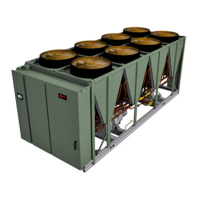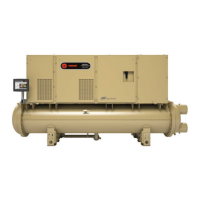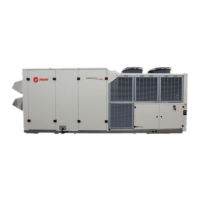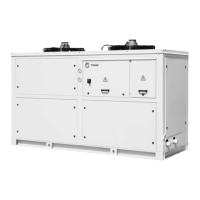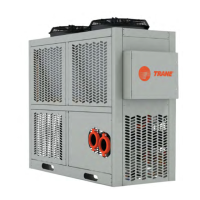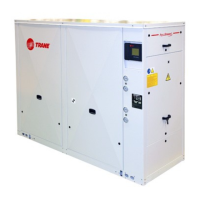AC-SVX001A-EN
67
6. At least every three months (quarterly), check the
refrigerant pressure in the unit to verify that the
refrigerant charge is intact.
Seasonal Unit Start-up
Procedure
1. PRIOR to water being pumped into system, use
gauges to verify positive pressure in the evaporator
and condenser. Lack of pressure could indicate a
system leak. When charging in the factory,
approximately 95% of the refrigerant charge is
isolated in the evaporator, and the other 5% is
contained in the condenser and compressor. In the
event that no pressure is present, contact local
Trane service.
2. Close all drain valves and re-install the drain plugs
in the evaporator.
3. Service the auxiliary equipment according to the
start-up/maintenance instructions provided by the
respective equipment manufacturers.
4. Close the vents in the evaporator chilled water
circuits.
5. Open all the valves in the evaporator chilled water
circuits.
6. Open all refrigerant valves to verify they are in the
open condition.
7. If the evaporator was previously drained, vent and
fill the evaporator and chilled water circuit. When
all air is removed from the system (including each
pass), install the vent plugs in the evaporator water
boxes.
8. Check the adjustment and operation of each safety
and operating control.
9. Refer to the sequence for daily unit startup for the
remainder of the seasonal startup.
System Restart After Extended
Shutdown
NNOOTTIICCEE
EEqquuiippmmeenntt DDaammaaggee!!
FFaaiilluurree ttoo ffoollllooww iinnssttrruuccttiioonnss ccoouulldd rreessuulltt iinn
eeqquuiippmmeenntt ddaammaaggee..
EEnnssuurree tthhaatt tthhee ccoommpprreessssoorr aanndd ooiill ssuummpp hheeaatteerrss
hhaavvee bbeeeenn ooppeerraattiinngg pprrooppeerrllyy ffoorr aa mmiinniimmuumm ooff 2244
hhoouurrss bbeeffoorree ssttaarrttiinngg..
Follow the procedures below to restart the unit after
extended shutdown:
1. Check refrigerant pressure as noted in Seasonal
Unit Start-Up procedure.
2. Verify that the liquid line service valves, oil line,
compressor discharge service valves and suction
service valves are open (backseated).
NNOOTTIICCEE
CCoommpprreessssoorr DDaammaaggee!!
FFaaiilluurree ttoo ffoollllooww iinnssttrruuccttiioonnss bbeellooww ccoouulldd ccaauussee
ccaattaassttrroopphhiicc ddaammaaggee ttoo tthhee ccoommpprreessssoorr..
DDoo nnoott lleeaavvee ooiill lliinnee sshhuutt ooffff vvaallvvee oorr tthhee iissoollaattiioonn
vvaallvveess cclloosseedd oonn uunniitt ssttaarrtt--uupp..
3. Check the oil sump level. See instructions in
Maintenance chapter.
4. Fill the evaporator water circuit. Vent the system
while it is being filled. Open the vent on the top of
the evaporator and condenser while filling and
close when filling is completed.
NNOOTTIICCEE
PPrrooppeerr WWaatteerr TTrreeaattmmeenntt RReeqquuiirreedd!!
TThhee uussee ooff uunnttrreeaatteedd oorr iimmpprrooppeerrllyy ttrreeaatteedd wwaatteerr
ccoouulldd rreessuulltt iinn ssccaalliinngg,, eerroossiioonn,, ccoorrrroossiioonn,, aallggaaee oorr
sslliimmee..
UUssee tthhee sseerrvviicceess ooff aa qquuaalliiffiieedd wwaatteerr ttrreeaattmmeenntt
ssppeecciiaalliisstt ttoo ddeetteerrmmiinnee wwhhaatt wwaatteerr ttrreeaattmmeenntt,, iiff
aannyy,, iiss rreeqquuiirreedd.. TTrraannee aassssuummeess nnoo rreessppoonnssiibbiilliittyy
ffoorr eeqquuiippmmeenntt ffaaiilluurreess wwhhiicchh rreessuulltt ffrroomm uunnttrreeaatteedd
oorr iimmpprrooppeerrllyy ttrreeaatteedd wwaatteerr,, oorr ssaalliinnee oorr bbrraacckkiisshh
wwaatteerr..
5. Close the fused-disconnect switches that provides
power to the chilled water pump.
6. Start the evaporator water pump and, while water
is circulating, inspect all piping for leakage. Make
any necessary repairs before starting the unit.
7. While the water is circulating, adjust the water
flows and check the water pressure drops through
the evaporator. See Evaporator Waterside Pressure
Drop Curves in Installation Mechanical chapter, and
water flow rates in General Data tables..
8. Verify proper operation of flow switch on the
evaporator waterbox.
9. Stop the water pump. The unit is now ready for
start-up as described previously
Sequence of Operation
This section provides basic information on chiller
operation for common events. Adaptive control
algorithms are used on these chillers. This section
illustrates common control sequences.
Software Operation Overview
The following figure is a diagram of the five possible
software states. This diagram can be thought of as a
state chart, with the arrows and arrow text, depicting
the transitions between states:
• The text in the circles is the internal software
designations for each state.
SSttaarrtt--uupp aanndd SShhuuttddoowwnn

